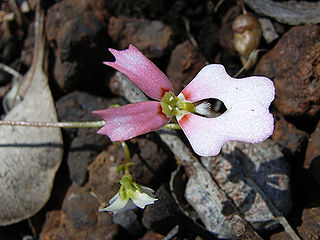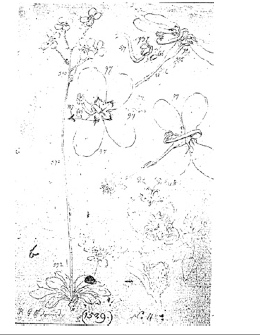Related Research Articles

Foxtail millet, scientific name Setaria italica, is an annual grass grown for human food. It is the second-most widely planted species of millet, and the most grown millet species in Asia. The oldest evidence of foxtail millet cultivation was found along the ancient course of the Yellow River in Cishan, China, carbon dated to be from around 8,000 years before present. Foxtail millet has also been grown in India since antiquity.

Stylidium is a genus of dicotyledonous plants that belong to the family Stylidiaceae. The genus name Stylidium is derived from the Greek στύλος or stylos, which refers to the distinctive reproductive structure that its flowers possess. Pollination is achieved through the use of the sensitive "trigger", which comprises the male and female reproductive organs fused into a floral column that snaps forward quickly in response to touch, harmlessly covering the insect in pollen. Most of the approximately 300 species are only found in Australia, making it the fifth largest genus in that country. Triggerplants are considered to be protocarnivorous or carnivorous because the glandular trichomes that cover the scape and flower can trap, kill, and digest small insects with protease enzymes produced by the plant. Recent research has raised questions as to the status of protocarnivory within Stylidium.
Stylidium tenellum is a dicotyledonous plant that belongs to the genus Stylidium. It is an annual plant that grows from 5 to 27 cm tall. The obovate or elliptical leaves, about 6-14 per plant, are scattered along the elongate, glabrous stem and are generally 3.5-8.5 mm long and 0.8-2.5 mm wide. Scapes are absent. Inflorescences are 2–8 cm long and produce white, pink, or mauve flowers that bloom from September to December in their native range. S. tenellum is endemic to Southeast Asia and its distribution ranges from southern India to southern China and south to Sumatra. In China it's known from Guangdong, Yunnan, and southern Fujian provinces. Its habitat is recorded as being seasonal swamps and is often reported to grow near rice paddies. It is usually found growing at low altitudes but has been recorded from elevations as high as 1100 metres on Sumatra. S. tenellum is most closely related to S. diffusum.

Andersonia is a subgenus of Stylidium that is characterized by a linear hypanthium, recurved mature capsule walls, an erect and persistent septum, and many seeds. This subgenus occurs in areas of tropical northern Australia and into Southeast Asia and was named in honour of William Anderson, the surgeon and naturalist who sailed with James Cook.

Stylidium section Alsinoida is a taxonomic rank under Stylidium subgenus Andersonia. In his 1908 monograph on the family Stylidiaceae, Johannes Mildbraed had established the subgenus Alsinoides for species related to S. alsinoides, which were morphologically similar to species of subgenus Andersonia. In 2000, A.R. Bean published a taxonomic revision of subgenus Andersonia and reduced subgenus Alsinoides to sectional rank, renamed Alsinoida.

Stylidium calcaratum, the book triggerplant, is a dicotyledonous plant that belongs to the genus Stylidium. It is an ephemeral annual that grows from 5 to 10 cm tall but can grow larger at 20–30 cm tall in damp forest or scrub habitat. The few ovate leaves produced by this plant form basal rosettes around the stem. The leaves are around 3–5 mm long on short petioles. The scapes are 2–30 cm tall and produce single flowers in smaller plants and up to nine flowers in larger, more robust plants. Flowers are pink or white with red spots or lines at the individual petal bases. The petals are vertically paired and will fold over to meet each other at night or in adverse weather conditions. S. calcaratum is endemic to Australia and has a distribution that ranges from Victoria through South Australia and into Western Australia. Its habitat is recorded as being wet flats or near creeks and seepages. Pollination is achieved by a grey fly, Comptosia cuneata.

Stylidium subg. Centridium is a subgenus of Stylidium that is characterized by a globose hypanthium, a stipitate brush-like stigma, and gynostemium mobility not produced by a sensitive hinged torosus but by the movement of a cunabulum. All species with the possible and doubtful exception of S. weeliwolli are annuals. This subgenus appears to be most closely related to the genus Levenhookia, which suggests an ancestral relationship. Centridium was first published by John Lindley in the 1839 publication, A Sketch of the Vegetation of the Swan River Colony. Lindley created this subgenus to distinguish species which did not fit into either of the two other subgenera that had existed at the time. He initially placed Stylidium calcaratum, the newly described Stylidium androsaceum, and Stylidium stipitatum into subgenus Centridium. His description of S. androsaceum turned out to be synonymous with S. calcaratum and S. stipitatum is a synonym of Levenhookia stipitata.

Stylidium ecorne is a dicotyledonous plant that belongs to the genus Stylidium. It is an annual plant that grows from 5 to 12 cm tall. It has pale or bright pink flowers and occurs in swampy areas.
Jackia may refer to any of three genera of plants, all named after William Jack (1795–1822):

Stylidium spathulatum is a dicotyledonous plant that belongs to the genus Stylidium. The species is informally named the creamy triggerplant for the colour of its flowers.

Stylidium affine is a species in the genus Stylidium that is endemic to Western Australia.
Eutaxia obovata may refer to:
Epidendrum subsect. Racemosa is a subsection belonging to section E. sect. Planifolia of subgenus E. subg. Epidendrum within the orchid family Orchidaceae. Plants classified under Racemosa differ from other subsections of E. sect. Planifolia in their production of raceme-like inflorescences. In 1861, Reichenbach identified 26 species within this subsection. These names correspond to 25 species currently recognized in the World Checklist of Selected Plant Families :
Spironema may refer to:
Celsia can refer to:

The APG IV system of flowering plant classification is the fourth version of a modern, mostly molecular-based, system of plant taxonomy for flowering plants (angiosperms) being developed by the Angiosperm Phylogeny Group (APG). It was published in 2016, seven years after its predecessor the APG III system was published in 2009, and 18 years after the first APG system was published in 1998. In 2009, a linear arrangement of the system was published separately; the APG IV paper includes such an arrangement, cross-referenced to the 2009 one.
Reticularia may refer to:
References
- ↑ APNI: Stylidium androsaceum. Australian Plant Name Index. Retrieved 25 August 2018.